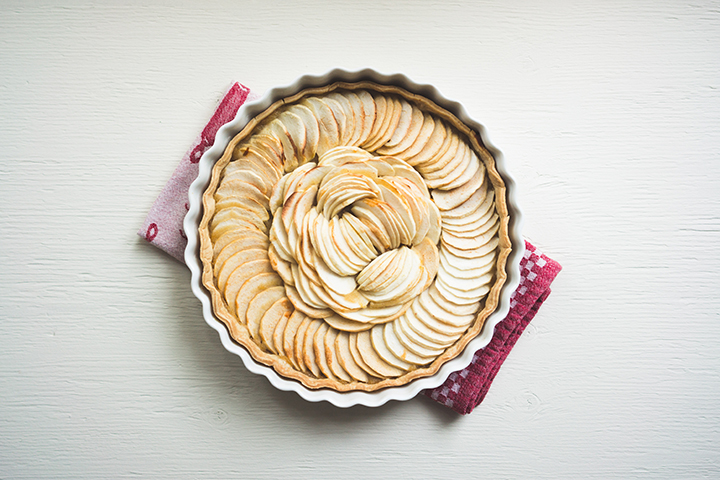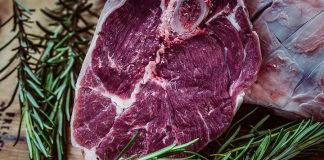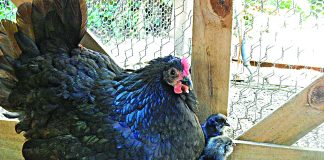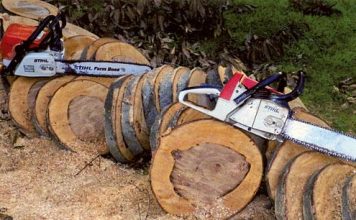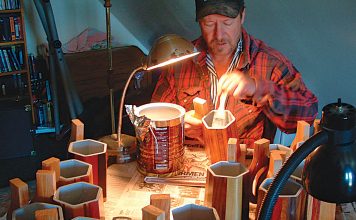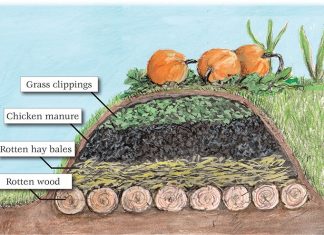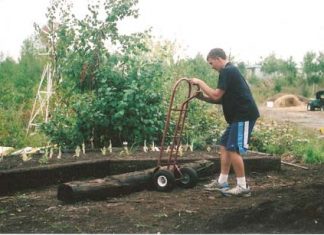 |
|
| Issue #48 • November/December, 1997 |
Early winter is my favorite time of the year to bake up a storm. Days are short, the weather is either rainy or cold, and it feels good to stay inside and create good things to eat by a warm woodstove. It also happens to be a great time to entertain, as my friends are often housebound as well, and we have a whole summerful of experiences that we were too busy to share until now.
French tarts are among the most elegant of desserts. The thin and crispy pastry with the fluted crust, the artful presentation of fruits, custards, lattices, and glazes, all are meant to be admired for their beauty as you pause before the first mouthful. And oh, that mouthful! Just as they are pleasing to the eye, they delight the palate with a symphony of flavors and textures.
The basic equipment required to make a French Tart are a rolling pin and a French tart pan. The French tart pan is a round pan with sides about 1-inch high which are fluted to make a pastry with a wavy crust. Look for them at kitchen specialty shops. The bottom of the pan is a separate piece which sits loosely in the edge piece. After baking, the edge piece is removed by placing your fingers underneath the bottom piece, and gently loosening and pulling down on the edge piece with your thumbs (this will work best if you are careful to bake the tart until the crust is done enough to pull away from the sides a little on its own). It’s a simple matter then to set the tart, bottom piece and all, on the serving platter. Slice with a sharp knife and serve with a spatula.
There is no reason why such a dessert must be full of un-healthy ingredients, though all too often they are. Fresh fruits, low-fat dairy products, and wholegrains can be prepared to the same high level of art as white flour and sugar, and indeed they will have more flavor! So go ahead, next time you want to wow your guests with an elegant dessert, prepare one of these fancy tarts. They will take more time to make than your everyday desserts, but they will be worth it!
| French tart pastryUse this recipe for your most elegant sweet pies and tarts. Makes one 10-inch crust. | |
1¼ cups whole wheat pastry flour ¼ cup oil |
2 Tbsp. honey 2 Tbsp. brandy |
Sift the flour into a medium bowl. While tossing the flour with a fork, drizzle the oil in a thin steady stream so that it is dispersed into the flour in tiny droplets. The mixture should resemble coarse meal. In a cup, stir the brandy and honey together with a fork until well-blended. Pour the wet mixture into the flour mixture all at once, and stir together with the fork. It will be very wet at first, but the flour will take up the moisture in a minute. If it is still too wet, add more flour a teaspoon at a time until you can form the dough into a ball. Cover the bowl and refrigerate 1 hour. Now take the ball of dough and flatten it into a disc with your hands. Put the disc between two sheets of waxed paper, and roll out to fit your pan. Remove one of the sheets of waxed paper, and leave the other one on until you have flipped the pastry into the pan. If you are using a french tart pan, you can cut the pastry to size merely by pushing it down on the sharp edge of the pan (after you have made sure to ease it down into all the corners). To prebake the crust, prick the bottom in several places with a fork, then line the crust with aluminum foil. Spread about a cup of dried beans out on the foil to weigh it down, then bake the whole thing for 15 to 20 minutes at 425 degrees. Remove the foil and beans, and keep them to use again for the same purpose. |
|
| Ricotta-almond tartThis beautiful pastry is both nutritious and delicious. Use any flavor preserves: my favorites are apricot and raspberry. Makes a 10-inch tart: | |
double recipe French tart pastry 2 egg yolks ¼ cup honey 1 Tbsp. whole wheat pastry flour 1 cup ricotta cheese |
½ tsp. almond extract 3 Tbsp. chopped almonds 2 egg whites, beaten ½ cup fruit preserves |
Make the French tart pastry. Divide it in two slightly uneven parts. Roll the larger part out very thin between two sheets of wax paper (save the scraps for a lattice). Line a 10-inch tart pan with it, lifting the dough and pressing it into the corners, using the edge of the pan to cut off the excess. In a medium bowl, beat the yolks and honey together until creamy. Beat in the flour, ricotta, and almond extract. Stir in the nuts. Fold in the beaten egg whites. Spread the preserves over the bottom of the pastry. Pour in the filling, and smooth over the top. Make a lattice of the rest of the pastry dough, as follows: roll the dough out between two pieces of waxed paper until it is the same diameter as the tart pan. Remove the top sheet of waxed paper. Cut the dough into half-inch wide strips, cutting right through the bottom sheet. Take the longest strip, put it across the center of the tart, paper side up, then remove the paper. Take the next longest strip, and lay it crosswise on the first, then remove the paper. Place the next two strips a half inch to each side of both these strips, and continue in this way until the top is covered with the lattice. Bake in a preheated 375 degree oven 40-45 minutes, until the top is golden and springy to the touch. This tastes best at room temperature, so if you have to refrigerate it, bring to room temperature again before serving. |
|
| Orange custard tartMake this dessert when you can get the very best in-season oranges. Temple or Valencia oranges have the best flavor. Makes one 10-inch tart. | |
¼ cup honey ¼ cup water 6 to 8 oranges 1 lemon |
2 eggs 3 Tbsp. cornstarch 1 French tart pastry, prebaked in a 10-inch french tart pan |
In a small saucepan, combine the honey and the water, and heat to simmering. Slice one of the oranges in half, and take 4 very thin slices off each half. Poach the slices gently in the syrup for 15 minutes, or until the white part of the rind turns transparent. Cool the slices in the syrup, then drain on paper towels. Reserve the remaining syrup. Squeeze enough juice from the remaining oranges to make 1¾ cups. Grate the lemon rind, and add the rind and juice of the lemon to the orange juice. Set aside ½ cup of juice in a small bowl. Combine the rest of the juice, the reserved honey syrup, and the cornstarch in a medium saucepan. Cook over medium heat, stirring constantly, until the mixture thickens and clears. Whisk the eggs into the reserved juice until very well combined, then pour in a steady stream into the hot mixture, whisking constantly. Immediately remove from heat. Taste: adjust sweetener (some oranges will be tarter than others). Spread the orange custard into the baked tart shell, then arrange the orange slices over it. Cool. Store in refrigerator. |
|
| Tarte aux pommes (apple tart)This is the simplest of tarts, just a crust with fruit, but it’s a French classic. Use sweet-tart apples which cook up very tender, such as Golden Delicious, Empires, Romes, or Macintosh, for this. Makes one 10-inch tart: | |
1 recipe French tart pastry 4 medium-large apples |
Glaze: 2 Tbsp. honey 2 tsp. oil 1 tsp. cinnamon 1 tsp. lemon juice |
Make the French tart pastry. Roll it out very thin between two sheets of wax paper. Line a 10-inch tart pan with it, lifting the dough and pressing it into the corners, using the edge of the pan to cut off the excess. Preheat oven to 400 degrees. Peel, quarter, and core the apples. Slice each quarter into about 6 thin wedges. Arrange them overlapping on the pastry in a pretty pattern: I like to make a large circle around the outside, and a fan or pinwheel in the middle. Use them however they fit and look best. If the apples are small, use more. Warm the honey, oil, and cinnamon just until they will mix. Stir in the lemon juice, and brush the mixture over the apple slices (use it all). Bake on the middle rack of the oven for 30 minutes. If the apples and edge of the crust begin to brown too quickly, cover lightly with foil. |
|


